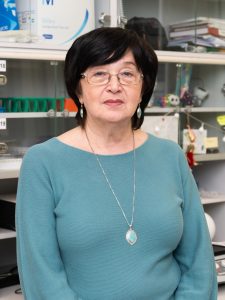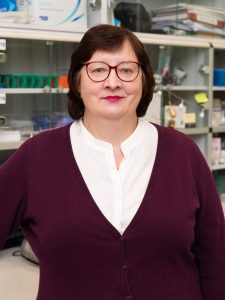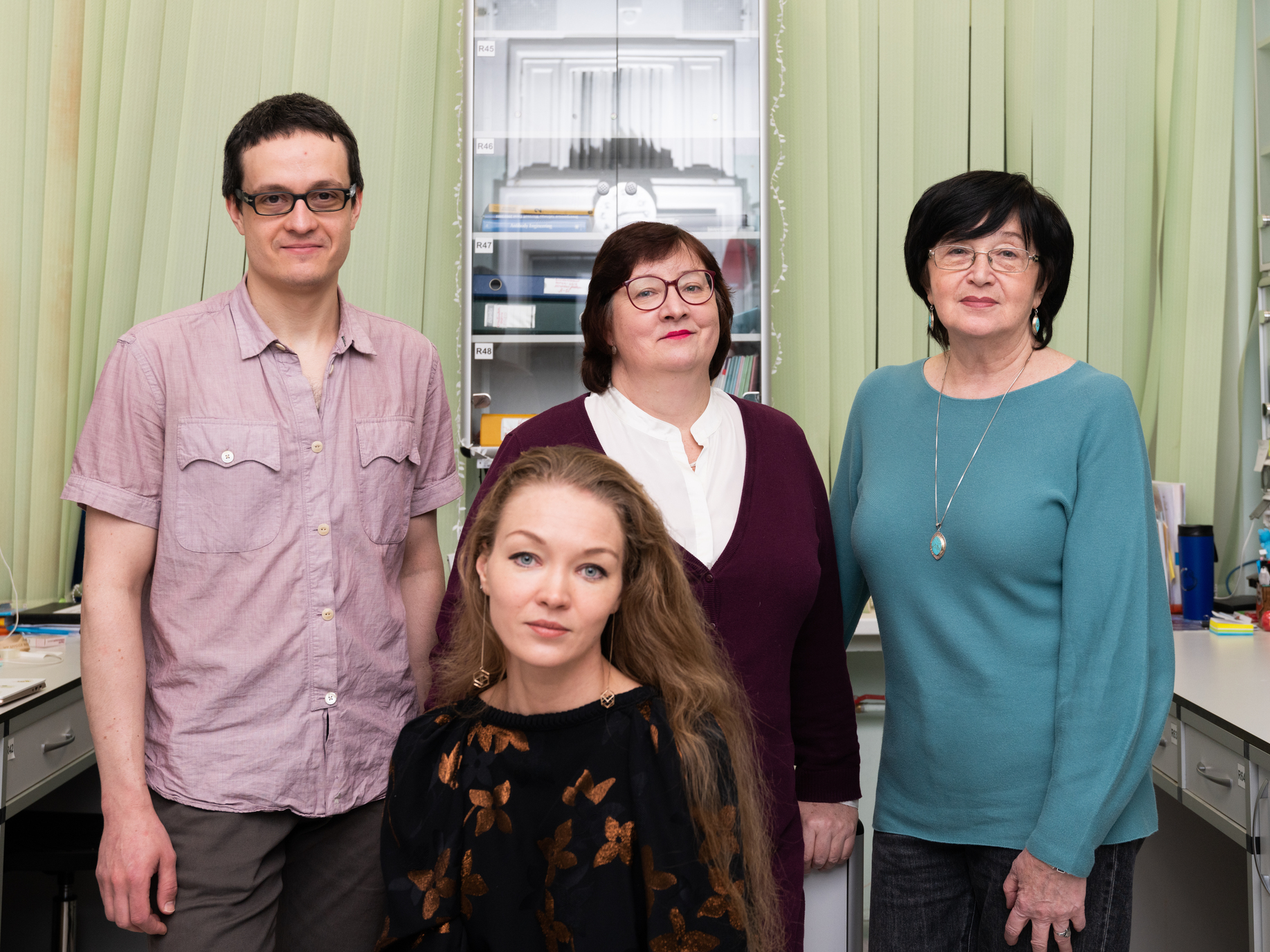Mechanism of mitochondria energy-transducing enzymes functioning

The group led by Honorary Professor of Moscow State University, Laureate of the U.S.S.R. State Prize, A.D. Vinogradov, was organized in 1960s when Bioenergetics became a rapidly growing and expanding area of Biochemistry. In 1970s, A.D. Vinogradov (that time a young assistant professor of Biochemistry Department) spent time as a Postdoctoral Fellow working in leading laboratories of the USA under the supervision of the founders of modern Bioenergetics, Prof. B. Chance (University of Pennsylvania), Prof. E. Racker (Cornell University), and Prof. T. Singer (Veteran Administration Hospital, San Francisco). In 1980, he was invited to New York State University as a visiting professor. Over 40 years of research activity the group contributed significantly to Bioenergetics as evident by more than two hundred papers published in peer-reviewed periodicals.
Among the priority contributions to the field are following. 1) Discovery of the cooperativity of the energy-linked Ca2+ accumulation by mitochondria (1972). 2) Kinetic and thermodynamic characteristics of succinate dehydrogenase–dicarboxylates interaction (1979). 3) Discovery of Ca2+-induced permeability transition in mitochondria (1972). 4) Direct demonstration of catalytic competence of the iron-sulfur center S-3 in the respiratory complex II (1975). 5) Discovery and isolation of new mitochondrial matrix-located enzyme, oxaloacetate keto-enol tautomerase and demonstration of tautomerase activity of aconitase (1988). 6) Discovery of ADP(Mg2+)-specific inhibitory binding site in the mitochondrial proton-translocating Fo•F1-ATPsynthase (1980). 7) Discovery of hysteretic behavior of the respiratory complex I (so-called A/D-transition, 1990). 8) Determination of the stoichiometry in energy-transduction catalyzed by the respiratory complex I (1999). 9) Introduction of several artificial electron acceptors for studies of the respiratory chain components (1977, 1983). 10) Discovery of ubisemiquinone as the intermediate of the energy-transduction mechanism of complex I (1989). 11) Discovery of ammonium-dependent reactive oxygen species (ROS) production by mitochondria and identification of dihydrolipoamide dehydrogenase as the enzyme responsible for this phenomenon.

Currently, three major problems are under active investigation by the group. One is the study of the “main” energy transducing enzyme, Fo•F1-ATPsynthase. The detailed analysis of the results obtained and published in a number of the original papers led to a new conceptual hypothesis: the energy-transducing enzymes are not simple reversibly operating catalysts, but they are the molecular machines which switch their mechanisms when operating in the forward or reverse directions.
The other area of interest is the reaction mechanisms involved in operation of the main energy-transducing respiratory enzyme, NADH:ubiquinone oxidoreductase (complex I). Particularly, slow transformation of the catalytic activity of complex I (A/D-transition), the phenomenon discovered in our laboratory, is under investigation. This phenomenon has been demonstrated to exist in purified enzymes, its membrane-bound form, in intact mitochondria, and, what seems to be most intriguing, in the perfused beating heart.
The third project is the quantitative study of ammonium-dependent ROS production by mitochondria as its dependence on their metabolic state (nature of the substrate oxidation, phosphorylation status). Also, molecular mechanism of activating effect of ammonium is under investigation.
The studies of the group were and are supported by the grants from the Russian Foundation for Fundamental Studies, grants from “Leading Schools in Science”, and the American National Institute of Health (NIH, Fogarty International Foundation).
All members of the group are involved in the teaching and other relevant activities. In 1991 A. Vinogradov took over the position of Chairman of the Department of Biochemistry, previously held by the founder of the Department, academician S.E. Severin. In 2001, he left this position following the University rule, unfortunately cancelled, concerning age-restrictions for administrative staff. Prof. A. Vinogradov is now a lecturer of the “Biochemistry” course for third year students of School of Biology. Dr. V. Grivennikova is a lecturer of the “Enzyme Kinetics” course for fourth year students specializing in biochemistry. Dr. T. Zharova is responsible for the “Enzymology” part of “The Practical Biochemistry” practical sessions. A. Vinogradov. Soros Professor, is the Chairman of the Council for Ph.D. and Dr.Sci. degrees, vice-Chairman of the Russian Bioenergetics Group, Member of the Central Council of the Russian Biochemical Society, member of the Editorial Boards of “Biochemistry, Moscow”, and Acta Biochimica Polonica. V.G. Grivennikova is a Soros Docent. Young members, Ph.D. students A.V. Kareyeva and G.V. Gladyshev are laureates of Moscow State University award to young scientists.
Twenty five students under Prof. Vinogradov’s supervision have received their PhD degrees. According to the University official rating site, Prof. A.D. Vinogradov and Dr V.G. Grivennikova are on the list of the most frequently sited authors at the Moscow State University.
Список статей
- Виноградов А.Д. (1999) Преобразование энергии в митохондриях, Соросовский образовательный журнал 9 (46), 11–19.
- Vinogradov A.D. (2000) Steady-state and pre-steady-state kinetics of the mitochondrial FoF1-ATPase: is ATP synthase a reversible molecular machine? J. Exp. Biol. 203, 41-49.
- Zharova T.V., Vinogradov A.D. (2006) Energy-linked binding of Pi is required for continuous steady-state proton-translocating ATP hydrolysis catalyzed by FoF1 ATP synthase. Biochemistry 45, 14552-14558.
- Kareyeva A.V., Grivennikova V.G., Vinogradov A.D. (2012) Mitochondrial hydrogen peroxide production as determined by the pyridine nucleotide pool and its redox state. Biochim. Biophys. Acta 1817, 1879-1885.
- Гривенникова В. Г., Виноградов А. Д. (2013) Генерация активных форм кислорода митохондриями, Успехи биологической химии, т. 53, 2013, с. 245–296.
- Grivennikova V.G. Kozlovsky V.S., Vinogradov A.D. Respiratory complex II: ROS production and the kinetics of ubiquinone reduction (2017) Biochim. Biophys. Acta, 1858, 109-117.
- Zharova T.V., Vinogradov A.D. Functional heterogeneity of Fo•F1H+-ATPase/synthase in coupled Paracoccus denitrificans plasma membranes (2017) Biochim. Biophys. Acta, 1858 939-944.
- Grivennikova V.G., Kareyeva A.V., Vinogradov A.D. (2018) Oxygen-dependence of mitochondrial ROS production as detected by Amplex Red assay, Redox Biol. 2018, 192–199.
- Gladyshev G.V., Grivennikova V.G., Vinogradov A.D. (2018) FEBS Lett. 2018 Jul;592(13):2213-2219. doi: 10.1002/1873-3468.13117
- Grivennikova V.G., Gladyshev G.V., Vinogradov A.D. (2020) FMN site-independent energy-linked reverse electron transfer in mitochondrial respiratory complex I, FEBS Lett. 592, 2213–2219.
- Grivennikova V.G., Gladyshev G.V., Vinogradov AD. (2020) Deactivation of mitochondrial NADH:ubiquinone oxidoreductase (respiratory complex I): Extrinsically affecting factors. Biochim Biophys Acta 1861, 148207.
Состав группы
| Group leader | V.G. Grivennikova |
| Senior staff scientist | T.V. Zharova |
| Research fellows | G.V. Gladyshev |
| Academic master | A.V. Kareyeva |
Room №: 156, 158, 160.
